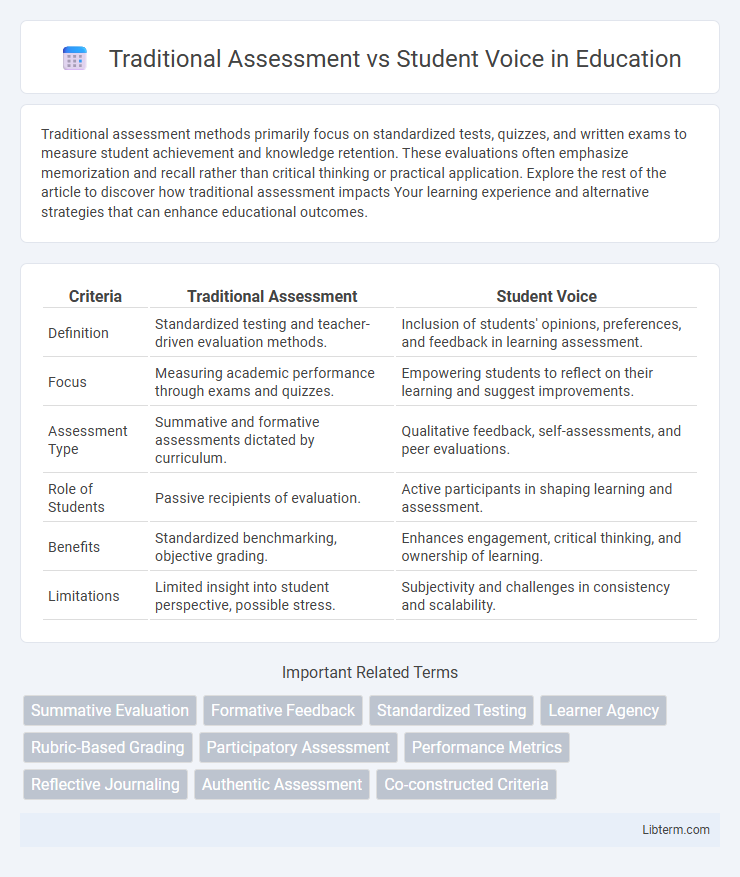Traditional assessment methods primarily focus on standardized tests, quizzes, and written exams to measure student achievement and knowledge retention. These evaluations often emphasize memorization and recall rather than critical thinking or practical application. Explore the rest of the article to discover how traditional assessment impacts Your learning experience and alternative strategies that can enhance educational outcomes.
Table of Comparison
| Criteria | Traditional Assessment | Student Voice |
|---|---|---|
| Definition | Standardized testing and teacher-driven evaluation methods. | Inclusion of students' opinions, preferences, and feedback in learning assessment. |
| Focus | Measuring academic performance through exams and quizzes. | Empowering students to reflect on their learning and suggest improvements. |
| Assessment Type | Summative and formative assessments dictated by curriculum. | Qualitative feedback, self-assessments, and peer evaluations. |
| Role of Students | Passive recipients of evaluation. | Active participants in shaping learning and assessment. |
| Benefits | Standardized benchmarking, objective grading. | Enhances engagement, critical thinking, and ownership of learning. |
| Limitations | Limited insight into student perspective, possible stress. | Subjectivity and challenges in consistency and scalability. |
Introduction to Traditional Assessment and Student Voice
Traditional assessment typically involves standardized tests, quizzes, and exams designed to measure student knowledge through predetermined criteria and structured formats. Student voice emphasizes incorporating learners' perspectives, experiences, and feedback into the educational process to foster engagement and personalized learning. These contrasting approaches highlight the shift from uniform evaluation methods toward more inclusive and participatory assessment practices.
Defining Traditional Assessment Methods
Traditional assessment methods primarily include standardized tests, quizzes, and exams designed to measure student knowledge and skills through objective criteria such as multiple-choice, true/false, or short answer questions. These assessments often emphasize memorization, recall, and the ability to perform under timed conditions, providing quantifiable data for grading and comparison. Critics argue that traditional assessments may not fully capture student creativity, critical thinking, or individual learning styles, leading to increased interest in incorporating student voice for a more holistic evaluation.
Understanding Student Voice in Education
Understanding student voice in education reveals how traditional assessment often overlooks the diverse perspectives, experiences, and insights students bring to the learning process. Incorporating student voice fosters a more inclusive and responsive educational environment, enhancing engagement and promoting deeper comprehension. Emphasizing student voice shifts the focus from standardized testing to meaningful dialogue, empowering learners to take ownership of their educational journey.
Historical Context: Evolution of Assessment Practices
Traditional assessment methods, rooted in early 20th-century educational reforms, primarily emphasized standardized testing and rote memorization to measure student achievement objectively. Over time, critiques highlighted limitations of these methods in capturing diverse learning styles and critical thinking skills. The rise of student voice as a pedagogical approach reflects a shift towards more inclusive, participatory assessment practices that value student perspectives and foster deeper engagement in the learning process.
Benefits of Traditional Assessment Approaches
Traditional assessment approaches provide structured and standardized methods to evaluate student knowledge, ensuring consistent measurement of learning outcomes across diverse populations. These assessments enable educators to efficiently identify specific areas of strength and weakness, facilitating targeted instruction and curriculum adjustments. Additionally, traditional assessments offer reliable data for institutional accountability and benchmarking academic performance over time.
Advantages of Incorporating Student Voice
Incorporating student voice in assessments fosters greater engagement by aligning evaluation methods with learners' interests and experiences, thereby enhancing motivation and participation. It promotes critical thinking and self-reflection, enabling students to take ownership of their learning process and develop metacognitive skills. This approach also supports personalized learning and equity by recognizing diverse perspectives and needs, leading to more accurate and meaningful measures of student understanding.
Challenges Faced by Traditional Assessment
Traditional assessment faces challenges such as limited ability to capture diverse learning styles and critical thinking skills, often relying heavily on standardized testing formats. It may also contribute to increased student anxiety and lack of engagement, as assessments typically emphasize rote memorization rather than meaningful understanding. These limitations hinder educators' ability to obtain a comprehensive picture of student learning and growth.
Obstacles to Embracing Student Voice
Traditional assessment methods often rely on standardized testing and rigid grading systems, which can limit educators' ability to incorporate student voice effectively. Obstacles to embracing student voice include institutional resistance, fear of losing control over classroom dynamics, and lack of professional development in facilitating student-led discussions. Overcoming these barriers requires systemic change and a shift towards more flexible, participatory evaluation practices that value student perspectives.
Bridging the Gap: Toward Balanced Assessment
Bridging the gap between traditional assessment and student voice requires integrating standardized tests with authentic student feedback to create a balanced evaluation approach. Emphasizing formative assessments alongside summative exams enhances learning by capturing students' perspectives and promoting deeper engagement. Data-driven insights combined with qualitative student input foster equitable and comprehensive measurement of academic progress.
Future Trends in Assessment and Student Engagement
Future trends in assessment emphasize a shift from traditional standardized tests toward methods that incorporate student voice, fostering personalized learning and higher engagement. Emerging technologies enable dynamic formative assessments that capture real-time student feedback, promoting active participation and adaptability in learning pathways. Integrating student perspectives into assessment design supports equity and motivation, shaping a more inclusive and effective educational environment.
Traditional Assessment Infographic

 libterm.com
libterm.com